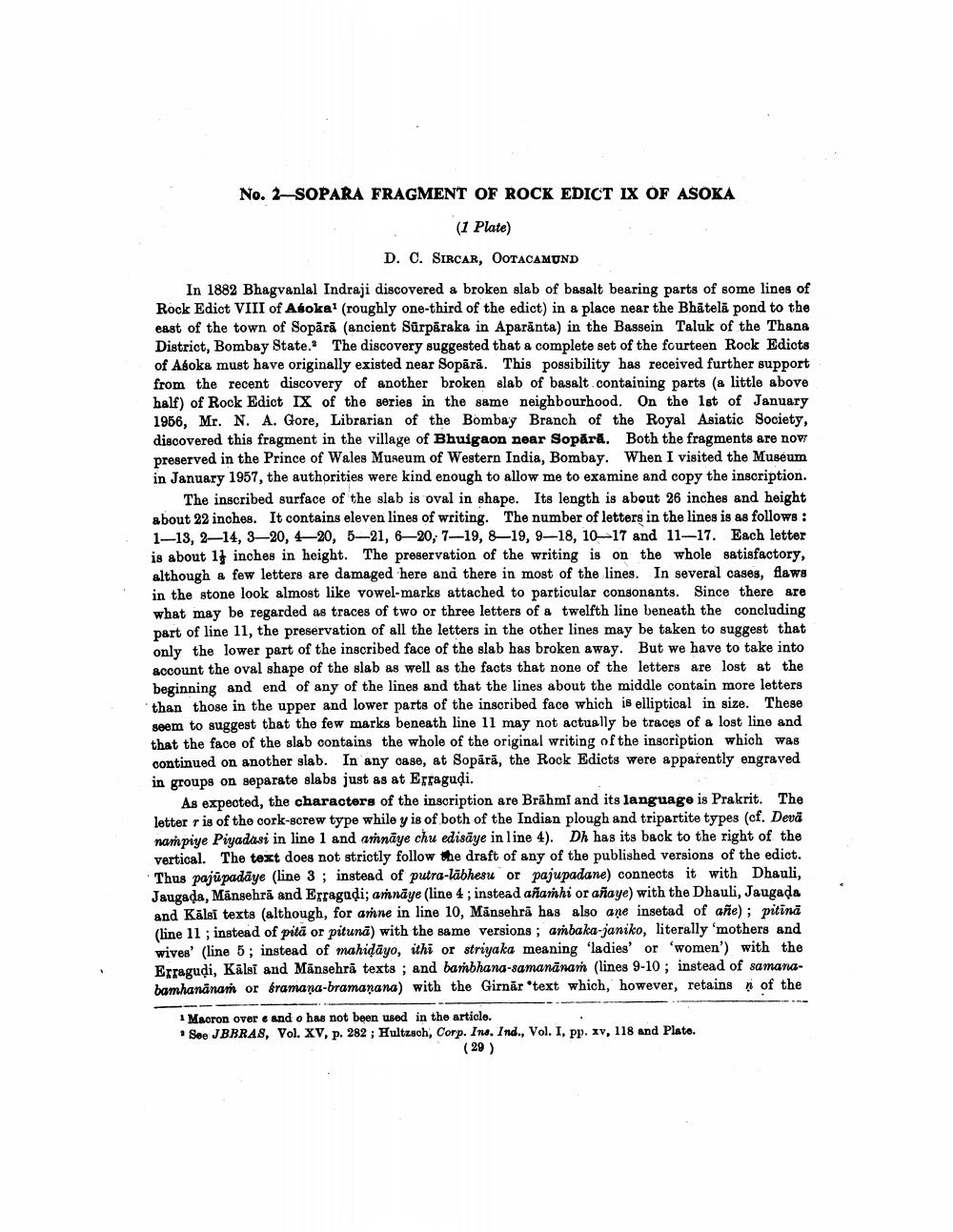________________
No. 2-SOPARA FRAGMENT OF ROCK EDICT IX OF ASOKA
(1 Plate) D. C. SIRCAR, OOTACAMUND
In 1882 Bhagvanlal Indraji discovered a broken slab of basalt bearing parts of some lines of Rock Edict VIII of Asoka! (roughly one-third of the edict) in a place near the Bhātelā pond to the east of the town of Sopārā (ancient Sürpāraka in Aparānta) in the Bassein Taluk of the Thana District, Bombay State. The discovery suggested that a complete set of the fourteen Rock Edicts of Asoka must have originally existed near Sopārā. This possibility has received further support from the recent discovery of another broken slab of basalt containing parts (a little above half) of Rock Edict IX of the series in the same neighbourhood. On the 1st of January 1956, Mr. N. A. Gore, Librarian of the Bombay Branch of the Royal Asiatic Society, discovered this fragment in the village of Bhuigaon near Sopārā. Both the fragments are now preserved in the Prince of Wales Museum of Western India, Bombay. When I visited the Museum in January 1957, the authorities were kind enough to allow me to examine and copy the inscription.
The inscribed surface of the slab is oval in shape. Its length is about 26 inches and height about 22 inches. It contains eleven lines of writing. The number of letters in the lines is as follows: 1-13, 214, 3 20, 420, 5-21, 6-20; 7—19, 819, 9-18, 10-17 and 11-17. Each letter is about 13 inches in height. The preservation of the writing is on the whole satisfactory, although a few letters are damaged here and there in most of the lines. In several cases, flaws in the stone look almost like vowel-marks attached to particular consonants. Since there are what may be regarded as traces of two or three letters of a twelfth line beneath the concluding part of line 11, the preservation of all the letters in the other lines may be taken to suggest that only the lower part of the inscribed face of the slab has broken away. But we have to take into account the oval shape of the slab as well as the facts that none of the letters are lost at the beginning and end of any of the lines and that the lines about the middle contain more letters than those in the upper and lower parts of the inscribed face which is elliptical in size. These seem to suggest that the few marks beneath line 11 may not actually be traces of a lost line and that the face of the slab contains the whole of the original writing of the inscription which was continued on another slab. In any case, at Sopārā, the Rock Edicts were apparently engraved in groups on separate slabs just as at Erragudi.
As expected, the characters of the inscription are Brahmi and its language is Prakrit. The letter r is of the cork-screw type while y is of both of the Indian plough and tripartite types (cf. Devā nan piye Piyadasi in line 1 and annāye chu edisāye in line 4). Dh has its back to the right of the vertical. The text does not strictly follow the draft of any of the published versions of the edict. Thus pajūpadāye (line 3; instead of putra-lābhesu or pajupadane) connects it with Dhauli, Jaugada, Mānsehrā and Erragudi; annäye (line 4; instead añanhi or añaye) with the Dhauli, Jaugada and Kälsi texts (although, for anne in line 10, Mansehra has also ane insetad of añe); pitinā (line 11 ; instead of pitā or pitunā) with the same versions ; ambaka-janiko, literally 'mothers and wives' (line 5; instead of mahidayo, ithi or striyaka meaning 'ladies' or 'women') with the Erragudi, Kālsī and Mansehra texts; and bambhana-samanānam (lines 9-10; instead of samanabamhananan or sramana-bramanana) with the Girnar 'text which, however, retains of the
1 Macron over & And o has not been used in the article. * See JBBRAS, Vol. XV, p. 282 ; Hultzsch, Corp. Ins. Ind., Vol. I, pp. xv, 118 and Plato.
( 29 )




